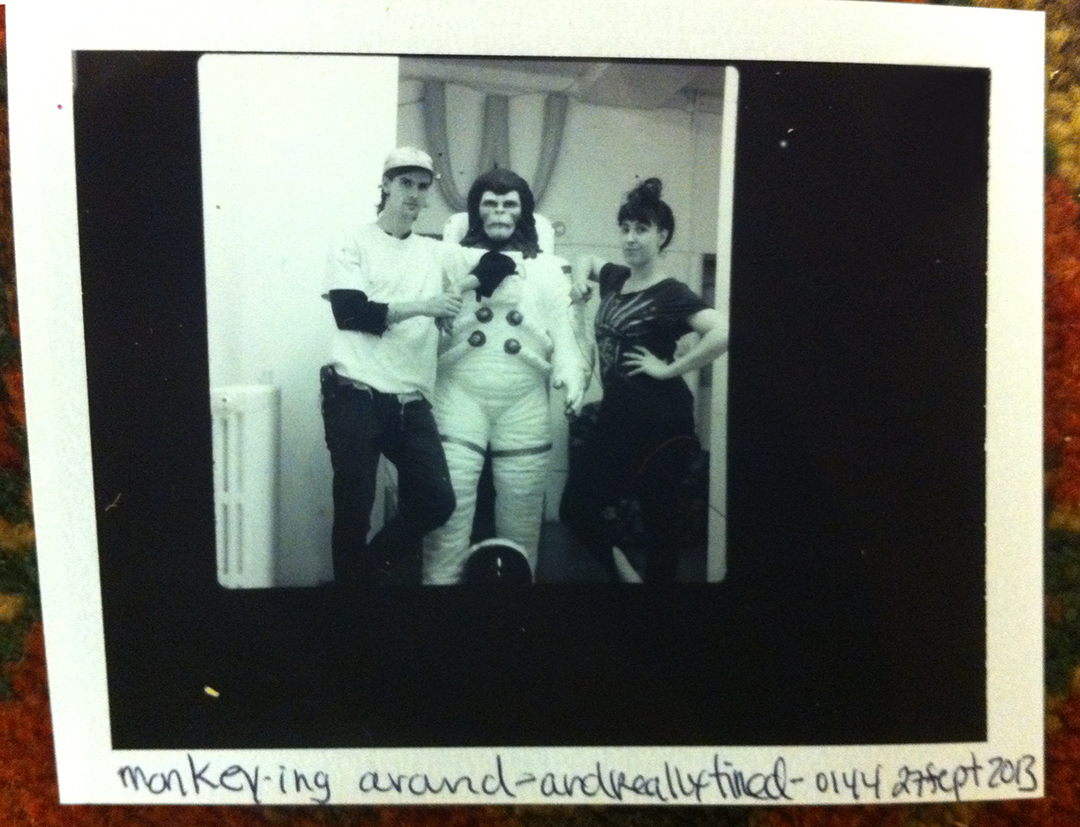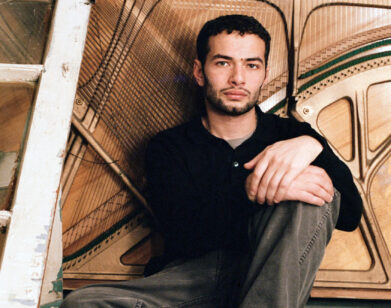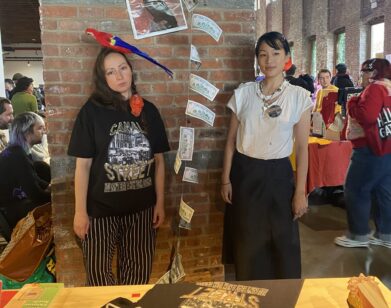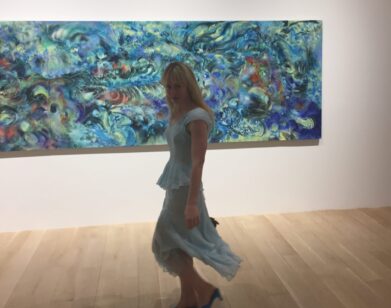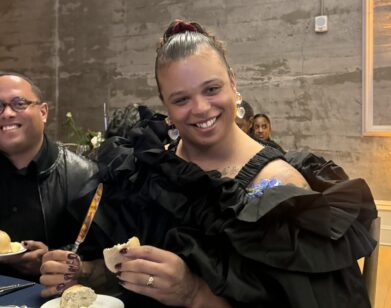Ventiko is a Renaissance Woman
Ventiko is a professional photographer and the host of downtown New York’s most insane monthly performance art series, the appropriately titled Performance Anxiety. Starting today, the Bushwick-based artist is taking her Brobdingnagian personality—along with 17 American artists featured in her burgeoning art project, The Animamus Art Salon and Living Gallery—to London.
To speak on Ventiko, especially to the uniformed, is to do all parties an injustice. Ventiko, a born master of ceremonies, boasts the gravitational pull of a small planet. Multi-talented and ever-evolving, she operates from the center of a community so large but so terminally underground that she could be mistaken for Brooklyn’s version of Joseph Conrad’s famous literary demigod, the iconic Kurtz, himself a former painter, writer and musician.
Interview came upon the often elusive but delightfully warm and self-deprecating Ventiko at her in-home studio in Brooklyn as she prepared for her residency in London.
KURT MCVEY: Tell us why you were in London and why you’re going back?
VENTIKO: I was in London because I needed to secure a location for my ongoing project, The Animamus Art Salon and Living Gallery. As you know, the very first time we held Animamus, it was at Culturefix. We featured a week of programming completely free and open to the public. The same exhibition later traveled to Brooklyn for Bushwick Open Studios at La Luz. After that it traveled to the Coohaus Gallery in Chelsea, and finally it will culminate during the entire month of October at Apiary Studios in London. Anyone and everyone is welcome to come and execute their vision, exchange ideas, host dinners, organize photo shoots—there’s a fully operational in-house photography studio—we’re going to do a conceptual haunted house, and we’re also hoping to refurbish a somewhat dilapidated rooftop greenhouse, depending on whether or not the roof holds up.
MCVEY: Is there a personal liaison, or maybe even a group of people helping you organize this project? It seems like a lot of work. Who is your London connection?
VENTIKO: Actually, I’m part of this collective called XVI. There’s 16 of us, hence the Roman numeral. We all gelled during a residency last summer and decided to pool our resources. I’m hoping to bring 17 New York-based artists together with the XVI London based-collective; that’s over 30 international artists living together and ultimately sharing their vision in one space.
MCVEY: So Animamus in London is really more of an ambitious cultural experiment.
VENTIKO: What is the artistic process and how does it vary between cultures? How do you build a community? I’m trying to answer these questions for myself, mostly. I think it’s all about sharing. It’s about taking a major leap and meeting new artists with varying backgrounds, all in real time, all free, and totally open, so the pressure to create is minimized.
MCVEY: Speaking of sharing, you’re launching a crowd-sourcing campaign to help fund this project. Why should people donate to Animamus?
VENTIKO: Well, I met this gentleman named Joshua Kogan in Far Rockaway right after Hurricane Sandy hit. We were both volunteering in the rubble way before the government or Red Cross was there, and we just bonded. Josh was a real inspiration. He explained that he created a website called Localflux.net, a crowd-sourcing platform that is centered around the dissemination of information regarding different projects, whether it be creating real-time awareness for a hurricane relief fund or an ambitious multi-cultural living art project. It’s not about making one video and hoping it sells the entire campaign. It’s about fostering the project through hands-on, written observations about how a project can and will continue to be successful.
MCVEY: How does someone choose an art project over funding for basic human necessities like hurricane relief, as you mentioned earlier? There are so many crowd-sourcing sites out there, and so many ambitious projects looking for attention on each of those individual sites. How do you stand apart?
VENTIKO: As Westerners, we are privileged enough to have the means to pursue and fully execute our dreams. Some of us have the luxurious choice to do what we will with our money. Art, and I think you will agree, has proven its importance on this planet over the last five or six centuries. But to answer your question, all I can say is that each artist within the Animamus community is just so giving, so beautiful as human beings, so loving, so encouraging, and so talented that they deserve some reciprocal support. Plus, on the site, you can see your contribution manifesting artistically in real time, which is exciting. I think that’s so cool. Art can save us. It pulled us out of the Dark Ages once, and one day, it will do it again.
MCVEY: Is that why the Renaissance as an overall aesthetic is so inspirational for you?
VENTIKO: It might also just be an excuse to get people to take their clothes off. [laughs] No, but really. Why should you donate to Animamus? Is art important? Sometime in the 14th century, a small selection of artists literally saved our species from falling into complete and utter despair. We have to remember that.
MCVEY: I wanted to ask you, Marina AbramoviÄ? has been everywhere lately. She did a performance art video with Lady Gaga and was prominently featured in a music video with Jay Z, two artists who seem to be rejecting this kind of hyperbolic materialism. Are major artists searching for a more organic way to connect with audiences, or are they reaching out to her because perhaps they’ve lost touch with their own artistic sense of self?
VENTIKO: In the West, artistic success is only quantifiable through proof of financial independence. Once that is achieved, however, you have to look deep within yourself for new inspiration. It’s easy to lose yourself when your commercial status overshadows your spiritual or artistic intent. I’m glad they’re reaching out to her. It surely can’t hurt.
MCVEY: Marina is in her late 60s. She’s been doing her thing for almost a half century now. Does it seem daunting that only now she’s experiencing this resurgence, this kind of “It” girl status at 66?
VENTIKO: It usually takes the mainstream a while to catch up.
MCVEY: Like Marina, are you aware of your status as a blossoming performance art matriarch, a nucleus or hub for a larger artistic community?
VENTIKO: I’m not Marina AbramoviÄ?, and you know how I feel about the “performance artist” moniker, but maybe I am nesting in my own way. A lot of my friends are pregnant or getting married. I’m not really interested in those things at the moment. What I am interested in is having similar support from a non-judgmental community that understands my fears, desires, insecurities, my intensity, and my sexuality, all of those things. I found that I, or other artists for that matter, didn’t really have a place to talk about these things openly. We’re in New York City, and it’s not cool, talking about these things. I saw how Animamus kept growing, how it kept getting bigger and bigger, and more importantly, how different everyone was; their socio-economic backgrounds, their particular mediums, even their unique emotional hang-ups. In freely and openly discussing our art, we were working out our issues without some pre-attached social stigma. Art is the conduit through which we could more openly discuss an endless stream of topics, without feeling crazy, out of touch, guarded, insecure, or God forbid, God forbid, pretentious.
MCVEY: I imagine the Salon is also a great place to discover new ideas. Someone could utter one sentence that could potentially set someone off on an entirely new artistic path.
VENTIKO: And nothing is taboo, and I mean nothing. We pride ourselves on being progressive. Artists are crushed by their inability to find time for their work. Others are concerned about money. Some are caught up in a particular medium or style and want to break free. Others are hung up on an ex or some other kind of abuse or rejection. We can help you get over it without it feeling like an intervention.
MCVEY: I want to talk about your solo show at The Coohaus Gallery back in May. It seems like critics are continually divided over your work. Some are taken aback by the nudity or the somewhat tongue-in-cheek sexual perversion. Others say you rely too heavily on your references. How do you feel the show was received?
VENTIKO: Coohaus was a very intimate, manageable space. My parents came. I sold some work. I got some press. I learned about the business a little more. Next time I would take a little more time to plan it. I would raise more funds initially for production costs and turn the overall exhibit into more of a happening. After the show, I will admit, there was this weird two-week period of down time, not free time, but a weird feeling of, I don’t know, now what?
MCVEY: A kind of artistic withdrawal?
VENTIKO: Yeah, I hear it’s common in all types of creative jobs. But again, we come back to Animamus. It was in devising this project that I found new inspiration. As I mentioned, there’s a fully functioning photography studio, multiple floors, so many interesting people. I’m hoping to hold upwards of 20 shoots in the space. I’m hoping to do a portrait for every artist involved. Maybe I’ll turn it into a book. I don’t know.
MCVEY: Do you see yourself moving away from the Renaissance nudes for your gallery work? Will you ever venture into commercial photography?
VENTIKO: You know, when I was younger, one of my inspirations, not so much visually, was David LaChapelle. He was influential for me because he was shooting on film in the beginning, all the props were real, and he was working with people who would let him control their image. These are people at a high level of celebrity. He showed me that you could make a great living as a photographer; the books, the album covers, Rolling Stone covers, ugh, don’t get me started. But I am nervous about getting caught up in that machine. And it is a machine. For so long, artists were taken to task just for commenting on the machine. “The pretension,” they cried! Now the machine operates with impunity.
MCVEY: Could Animamus be the beginning of a new Renaissance?
VENTIKO: Why not?
THE ANIMAMUS ART SALON AND LIVING GALLERY WILL BE IN RESIDENCE AT LONDON’S APIARY STUDIOS THROUGHOUT THE MONTH OF OCTOBER. FOR MORE INFORMATION, VISIT ITS WEBSITE.

